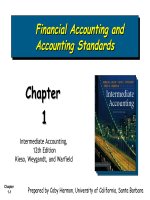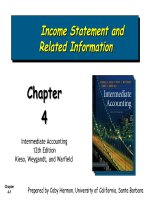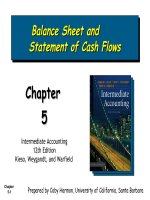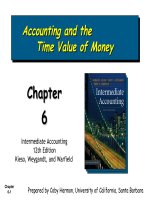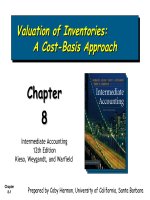Intermediate accounting 12th edition kieso warfield chapter 10
Bạn đang xem bản rút gọn của tài liệu. Xem và tải ngay bản đầy đủ của tài liệu tại đây (380.93 KB, 41 trang )
Acquisition
Acquisition and
and Disposition
Disposition of
of
Property,
Property, Plant,
Plant, and
and Equipment
Equipment
Chapter
10
Intermediate Accounting
12th Edition
Kieso, Weygandt, and Warfield
Chapter
10-1
Prepared by Coby Harmon, University of California, Santa Barbara
Learning
Learning Objectives
Objectives
1.
Describe property, plant, and equipment.
2.
Identify the costs to include in initial valuation of property,
plant, and equipment.
3.
Describe the accounting problems associated with selfconstructed assets.
4.
Describe the accounting problems associated with interest
capitalization.
5.
Understand accounting issues related to acquiring and valuing
plant assets.
6.
Describe the accounting treatment for costs subsequent to
acquisition.
7.
Describe the accounting treatment for the disposal of property,
plant, and equipment.
Chapter
10-2
Acquisition
Acquisition and
and Disposition
Disposition of
of
Property,
Property, Plant,
Plant, and
and Equipment
Equipment
Acquisition
Acquisition costs:
Land, buildings,
equipment
Self-constructed
assets
Interest costs
Observations
Valuation
Cash discounts
Deferred
contracts
Lump-sum
purchases
Stock issuance
Nonmonetary
exchanges
Contributions
Other valuation
methods
Chapter
10-3
Cost
Subsequent to
Acquisition
Additions
Improvements
and
replacements
Rearrangement
and reinstallation
Repairs
Summary
Dispositions
Sale
Involuntary
conversion
Miscellaneous
problems
Property,
Property, Plant,
Plant, and
and Equipment
Equipment
Property, plant, and equipment includes land, buildings,
and equipment (machinery, furniture, tools).
Major characteristics include:
“Used in operations” and not for resale.
Long-term in nature and usually depreciated.
Possess physical substance.
Chapter
10-4
LO 1 Describe property, plant, and equipment.
Acquisition
Acquisition and
and Valuation
Valuation of
of PP&E
PP&E
Valued at Historical Cost, reasons include:
At acquisition, cost reflects fair value.
Historical cost is reliable.
Companies should not anticipate gains and losses but
should recognize gains and losses only when the asset
is sold.
APB Opinion No. 6 states,
“property, plant, and
equipment should not be
written up to reflect
appraisal, market, or
current values which are
above cost.”
Chapter
10-5
LO 2 Identify the costs to include in initial valuation
of property, plant, and equipment.
Acquisition
Acquisition and
and Valuation
Valuation of
of PP&E
PP&E
Cost of Land
Includes all costs to acquire land and ready it for use.
Costs typically include:
(1) the purchase price;
(2) closing costs, such as title to the land, attorney’s
fees, and recording fees;
(3) costs of grading, filling, draining, and clearing;
(4) assumption of any liens, mortgages, or encumbrances
on the property; and
(5) Additional land improvements that have an indefinite
life.
Chapter
10-6
LO 2 Identify the costs to include in initial valuation
of property, plant, and equipment.
Acquisition
Acquisition and
and Valuation
Valuation of
of PP&E
PP&E
Cost of Buildings
Includes all costs related directly to acquisition or
construction.
Costs typically include:
(1) materials, labor, and overhead costs incurred during
construction and
(2) professional fees and building permits.
Chapter
10-7
LO 2 Identify the costs to include in initial valuation
of property, plant, and equipment.
Acquisition
Acquisition and
and Valuation
Valuation of
of PP&E
PP&E
Cost of Equipment
Include all costs incurred in acquiring the equipment
and preparing it for use.
Costs typically include:
(1) purchase price,
(2) freight and handling charges
(3) insurance on the equipment while in transit,
(4) cost of special foundations if required,
(5) assembling and installation costs, and
(6) costs of conducting trial runs.
Chapter
10-8
LO 2 Identify the costs to include in initial valuation
of property, plant, and equipment.
Acquisition
Acquisition and
and Valuation
Valuation of
of PP&E
PP&E
E10-1 (Acquisition Costs of Realty) The following expenditures
and receipts are related to land, land improvements, and buildings
acquired for use in a business enterprise. Determine how the
following should be classified:
Classification
(a) Money borrowed to pay building contractor
(b) Payment for construction from note proceeds
Notes Payable
Building
(c) Cost of land fill and clearing
Land
(d) Delinquent real estate taxes on property
assumed
Land
(e) Premium on insurance policy during
construction
(f) Refund of 1-month insurance premium because
construction completed early
Chapter
10-9
Building
(Building)
LO 2 Identify the costs to include in initial valuation
of property, plant, and equipment.
Acquisition
Acquisition and
and Valuation
Valuation of
of PP&E
PP&E
E10-1 (Acquisition Costs of Realty) The following expenditures
and receipts are related to land, land improvements, and buildings
acquired for use in a business enterprise. Determine how the
following should be classified:
Costs of:
Building
(g) Architect’s fee on building
(h) Cost of real estate purchased as a plant site
(land $200,000 and building $50,000)
Land
(i) Commission fee paid to real estate agency
Land
(j) Installation of fences around property
Land Improvements
(k) Cost of razing and removing building
(l) Proceeds from salvage of demolished building
(m) Cost of parking lots and driveways
(n) Cost of trees and shrubbery (permanent)
Chapter
10-10
Land
(Land)
Land Improvements
Land
LO 2 Identify the costs to include in initial valuation
of property, plant, and equipment.
Acquisition
Acquisition and
and Valuation
Valuation of
of PP&E
PP&E
Self-Constructed Assets
Costs typically include:
(1) Materials and direct labor
(2) Overhead can be handled in two ways:
1. Assign no fixed overhead
2. Assign a portion of all overhead to the
construction process.
Companies use the second method extensively.
Chapter
10-11
LO 3 Describe the accounting problems associated with self-constructed assets.
Acquisition
Acquisition and
and Valuation
Valuation of
of PP&E
PP&E
Interest Costs During Construction
Three approaches have been suggested to account for the
interest incurred in financing the construction.
$ 0
Capitalize no
interest
during
construction
Increase to Cost of Asset
Capitalize actual
costs incurred
during construction
(with modification)
$ ?
Capitalize
all costs of
funds
Illustration 10-1
GAAP
Chapter
10-12
LO 4 Describe the accounting problems associated with interest capitalization.
Acquisition
Acquisition and
and Valuation
Valuation of
of PP&E
PP&E
Interest Costs During Construction
GAAP requires — capitalizing actual interest (with
modification).
Consistent with historical cost — all costs incurred to
bring the asset to the condition for its intended use.
Capitalization considers three items:
1. Qualifying assets.
2. Capitalization period.
3. Amount to capitalize.
Chapter
10-13
LO 4 Describe the accounting problems associated with interest capitalization.
Acquisition
Acquisition and
and Valuation
Valuation of
of PP&E
PP&E
Qualifying Assets
Require a period of time to get them ready for their
intended use.
Two types of assets:
Assets under construction for a company’s own use.
Assets intended for sale or lease that are
constructed or produced as discrete projects.
Chapter
10-14
LO 4 Describe the accounting problems associated with interest capitalization.
Acquisition
Acquisition and
and Valuation
Valuation of
of PP&E
PP&E
Capitalization Period
Begins when:
1.
Expenditures for the asset have been made.
2.
Activities for readying the asset are in progress .
3.
Interest costs are being incurred.
Ends when:
The asset is substantially complete and ready for use.
Chapter
10-15
LO 4 Describe the accounting problems associated with interest capitalization.
Acquisition
Acquisition and
and Valuation
Valuation of
of PP&E
PP&E
Amount to Capitalize
Capitalize the lesser of:
Chapter
10-16
1.
Actual interest costs
2.
Avoidable interest - the amount of interest
that could have been avoided if expenditures
for the asset had not been made.
LO 4 Describe the accounting problems associated with interest capitalization.
Acquisition
Acquisition and
and Valuation
Valuation of
of PP&E
PP&E
Interest Capitalization Illustration: Delmar Corporation
borrowed $200,000 at 12% interest from State Bank on Jan. 1,
2005, for specific purposes of constructing special-purpose
equipment to be used in its operations. Construction on the
equipment began on Jan. 1, 2005, and the following expenditures
were made prior to the project’s completion on Dec. 31, 2005:
Actual Expenditures:
January 1, 2005
April 30, 2005
November 1, 2005
December 31, 2005
Total expenditures
Chapter
10-17
$100,000
150,000
300,000
100,000
$650,000
Other general debt existing
on Jan. 1, 2005:
$500,000, 14%, 10-year
bonds payable
$300,000, 10%, 5-year
note payable
LO 4 Describe the accounting problems associated with interest capitalization.
Acquisition
Acquisition and
and Valuation
Valuation of
of PP&E
PP&E
Step 1 - Determine which assets qualify for
capitalization of interest.
Special purpose equipment qualifies because it
requires a period of time to get ready and it will be
used in the company’s operations.
Step 2 - Determine the capitalization period.
The capitalization period is from Jan. 1, 2005
through Dec. 31, 2005, because expenditures are
being made and interest costs are being incurred
during this period while construction is taking place.
Chapter
10-18
LO 4 Describe the accounting problems associated with interest capitalization.
Acquisition
Acquisition and
and Valuation
Valuation of
of PP&E
PP&E
Step 3 - Compute weighted-average accumulated
expenditures.
Date
Jan. 1
Apr. 30
Nov. 1
Dec. 31
Actual
Capitalization
Expenditures
Period
$ 100,000
12/12
150,000
8/12
300,000
2/12
100,000
0/12
$ 650,000
Weighted
Average
Accumulated
Expenditures
$ 100,000
100,000
50,000
$ 250,000
A company weights the construction expenditures by the amount of time
(fraction of a year or accounting period) that it can incur interest cost on
the expenditure.
Chapter
10-19
LO 4 Describe the accounting problems associated with interest capitalization.
Acquisition
Acquisition and
and Valuation
Valuation of
of PP&E
PP&E
Step 4 - Compute the Actual and Avoidable Interest.
Selecting Appropriate Interest Rate:
Chapter
10-20
1.
For the portion of weighted-average accumulated
expenditures that is less than or equal to any amounts
borrowed specifically to finance construction of the
assets, use the interest rate incurred on the specific
borrowings.
2.
For the portion of weighted-average accumulated
expenditures that is greater than any debt incurred
specifically to finance construction of the assets, use a
weighted average of interest rates incurred on all other
outstanding debt during the period.
LO 4 Describe the accounting problems associated with interest capitalization.
Acquisition
Acquisition and
and Valuation
Valuation of
of PP&E
PP&E
Step 4 - Compute the Actual and Avoidable Interest.
Actual Interest
Specific Debt
General Debt
$
Interest
Actual
Debt
Rate
Interest
200,000
12%
500,000
14%
70,000
300,000
10%
30,000
$1,000,000
Avoidable Interest
$
$ 124,000
$100,000
$800,000
= 12.5%
Accumulated
Interest
Avoidable
Expenditures
Rate
Interest
$ 200,000
12%
50,000
$ 250,000
Chapter
10-21
24,000
Weighted-average
interest rate on
general debt
$
12.5%
24,000
6,250
$
30,250
LO 4 Describe the accounting problems associated with interest capitalization.
Acquisition
Acquisition and
and Valuation
Valuation of
of PP&E
PP&E
Step 5 – Capitalize the lesser of Avoidable
interest or Actual interest.
Avoidable interest
Actual interest
$
30,250
124,000
Journal entry to Capitalize Interest:
Equipment
Interest expense
Chapter
10-22
30,250
30,250
LO 4 Describe the accounting problems associated with interest capitalization.
Valuation
Valuation
Generally
Companies should record property, plant, and
equipment:
at the fair value of what they give up or
at the fair value of the asset received,
whichever is more clearly evident.
Chapter
10-23
LO 5 Understand accounting issues related to acquiring and valuing plant assets.
Valuation
Valuation
Cash Discounts — whether taken or not — generally
considered a reduction in the cost of the asset.
Deferred-Payment Contracts — Assets, purchased
through long term credit, are recorded at the present value
of the consideration exchanged.
Lump-Sum Purchases — Allocate the total cost among
the various assets on the basis of their fair market values.
Issuance of Stock — The market value of the stock
issued is a fair indication of the cost of the property
acquired.
Chapter
10-24
LO 5 Understand accounting issues related to acquiring and valuing plant assets.
Valuation
Valuation
Exchanges of Nonmonetary Assets
Ordinarily accounted for on the basis of:
the fair value of the asset given up or
the fair value of the asset received,
whichever is clearly more evident.
Companies should recognize immediately any gains or losses
on the exchange when the transaction has commercial
substance (future cash flows change as a result of the
transaction).
Chapter
10-25
LO 5 Understand accounting issues related to acquiring and valuing plant assets.


